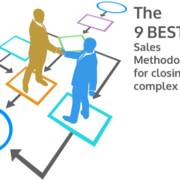How to Spot a Weak Deal Before It Wastes Your Time

The saying “one rotten apple in the entire fresh fruit basket can spoil the whole bunch” is rightly said and shouldn’t be taken lightly. This concept is also applicable for any sales process deal. In the jam-packed, demanding, and hectic sales environment, sales reps have a limited amount of time and should focus only on interacting with potential prospects who are likely to convert into loyal customers.
However, this is quite different from the current scenario, where the salespeople spend their time and energy chasing random or bad leads from the start. This happens because there is no strategic sales process that they follow. Most of them still rely on outdated, non-data-driven, word-of-mouth sales methods instead of creating a customized strategic close deals plan that works for your specific organization. This can lead to a never-ending cycle of bad deals and slipped deals. If no action is taken to improve deal qualification, your team can lose solid convertible leads even before the nurturing stage.
Moreover, if your company sales manager can crack the “sales deal cheat code,” significant changes can be seen in just a few months. Sales reps will no longer struggle to hit their quota or monthly or quarterly goals without focusing on random bulk lead nurturing data. Instead, they are focusing on a small percentage of high-value prospects to close more deals and make more accurate forecasts, improving overall sales efficiency.
Though this might sound great in theory, practically it can be difficult for sales reps trying to differentiate between great opportunities and terrible time sinks, especially in the initial stages of the sales cycle. This is why not just a traditional good sales attitude will improve your sales performance but knowing how to avoid time wasters will be your savior.
The Sales Deal Cheat Code Exists — You Just Need the Right System
Yes, it’s not going to be a walk in the park, but worry not, we just have the right sales strategy for you. No matter if you are a startup, small organization, MNC, or a company that can’t afford a full-fledged strategic sales process.
In this scenario, you need a quick and modern solution like iSEEit Opportunity Management that are a clearer indicator that your sales deal is bad right from the start. iSEEit integrates into Salesforce and visually guides sales reps through each sales process stage from qualifying leads, mapping relationships, and tracking progress using MEDDIC or your custom methodology. No more scattered notes, misalignment, or mystery deals. Just clarity to avoid getting involved in the bad sales loop.
Here Are 8 Telltale Signs You’re Chasing a Weak Deal — And What To Do About It
1) Vague About the Pain Point
MEDDIC Principle: Identifying the prospect’s core pain points is the first step to differentiate if your lead will turn out to be cold or not.
- Red flag: If a prospect is consistently vague about their business pain, needs, or goals in company operations or decision-making timelines. This is a clear indicator they are generally not going to commit to sales solutions.
- Action: Begin with asking probing questions to discover the tangible business challenge. This will help you cross-check if their organization’s pain point aligns with the business solution you are offering. This phase is a vital step in learning how to close deals efficiently.
- iSEEit Solution: Use iSEEit’s built-in qualifier prompts to discover the clients true pain points for goal alignment earlier in the sales deal.
2) No Clear Business Impact
MEDDIC Principle: Creating deal urgency by highlighting the negative business impact if the pain is not addressed.
- Red flag: If prospects are not consistent in their interest and consistently miss appointments or reply late, it might be a clear signal that they are not serious about moving forward. This categorizes them as “nice-to-have” leads, not “must-haves.”
- Action: Clearly explain the pain point, or the impact it might have on their business in the long run. If there is still a lack of urgency or an unclear timeline continues, it’s a sign to walk away.
- iSEEit Solution: Leverage deal health indicators to highlight low-engagement accounts and reallocate your focus to other deals.
3) No Identifiable Sales Champion
MEDDIC Principle: Discover the key player within the prospect’s organization who will be your direct POC and advocate for your solution to close more deals.
- Red flag: If you’re dealing with a prospect who is unwilling to introduce you to the right decision-makers, or they are evasive in providing clear information. That is a clear clue that there is no real champion for your solution in that organization.
- Action: Identify the “sales champion” who has active participation in the sales process and can support your solution internally. If your POC is not a decision-maker or can’t guide you through the process, simply move to the next.
- iSEEit Solution: Build stakeholder org charts to analyze and visualize internal relationships to create a list of potential decision-makers.
4) Missed Appointments and Slow Replies
MEDDIC Principle: A lack of commitment or follow-through is a strong indicator of a lead that’s not a priority for the prospect.
- Red Flag: Consistent no-shows or slow responses are generally a clear indicator that the lead is not interested. If they are not responsive in the beginning, they’ll likely continue to be a drain on your time.
- Action: If follow-up replies or meetings are constantly ignored, it’s a clear sign of low engagement. Now is the time to apply your energy where you can close deals faster.
- iSEEit Solution: Use iSEEit’s visual progress tracker to easily spot deals that are stagnating and take proactive action early on.
5) Mismatched Budget Expectations
MEDDIC Principle: The key principle here is to ensure that the prospect’s budget is in alignment with the price of your solution.
- Red Flag: If the prospect’s financial budget doesn’t match your current pricing structure or they are asking huge favors. You are clearly wasting your time on a deal that will never close.
- Action: While negotiating the sales deals, don’t sacrifice company profitability for the sake of closing. In cases like this, use sales tools to evaluate how you can create a win-win situation for both parties. If still they ask for major discounts that might hurt your ROI, simply walk away if there’s no financial alignment.
- iSEEit Solution: iSEEit’s deal checklist ensures budget discussions aren’t missed to help you spot any initial financial misalignment.
6) Unrealistic Demands or Expectations
MEDDIC Principle: Strategically discover how your solution meets the prospect’s needs, as well as what their expectations are in terms of outcomes.
- Red flag: If the lead demands constant attention and an extensive amount of information with unrealistic outcome expectations. It is a clear indication that it’s not a mutually beneficial deal, and you should refocus on more promising leads.
- Action: During negotiation, if the prospect is expecting a complete turnaround with minimal investment. In this case, you need to set clear expectations from the start to avoid misalignment later.
- iSEEit Solution: Helps define and document the decision criteria early so prospects’ expectations are managed from day one.
7) The Prospect Goes Cold Over Time
MEDDIC Principle: Follow-through is key in sales prospecting to determine if the customer is enthusiastic enough or if their pain is strong enough to turn them into a potential lead.
- Red Flag: A prospect who was open and receptive in the beginning but loses interest over time is a clear sign that their decision-making process is unpredictable.
- Action: If the organization loses interest or goes cold after the first meetup, it might not be worth engaging with. Instead, direct those efforts towards high-potential customers to close deals efficiently.
- iSEEit Solution: Provides action-oriented deal visualization to take proactive steps in deciding to walk away from a deal to avoid time wasters.
8) Customer Lacks Transparency
MEDDIC Principle: Building trust from both sides is a critical aspect of any sales process.
- Red Flag: During the deal negotiation, if you come across any red flags such as dishonesty, evasive answers, or inconsistent information. This is a clear-cut sign of a rotten deal.
- Action: If the buyer is not transparent about their needs, timeline, or budget, you could be walking into a deal that’s never going to close. In such scenarios, trust your first instincts and thoroughly verify the prospect’s credibility. This step can protect you from slipped deals and lost time.
- iSEEit Solution: iSEEit’s mutual close plans keep all the decision-makers aligned to ensure visibility and accountability within the sales process.
Final Thoughts: Walk Away From Bad Apples Early
If you apply MEDDIC to your sales qualification process, you can quickly identify the “rotten apples” in the early stage, such as unresponsive leads, prospects with mismatched budgets, or those lacking clarity and urgency. The goal here is to focus your efforts on the high-value opportunities that align with your sales journey and avoid time wasters. This ensures your resources are spent on prospects who are likely to convert into potential loyal customers and close more deals.
Using this MEDDIC methodology, you can streamline the qualification process and prevent sales reps from getting stuck in the never-ending cycle of chasing low-quality leads. In conclusion, a positive sales attitude, combined with a MEDDIC sales process and iSEEit tools, will help you successfully navigate complex deals, build better pipelines, and make more accurate forecasts.
Sales reps using iSEEit Opportunity Management report a performance hike of over 50%, not because they’re working harder, but because they’re qualifying smarter. The tool empowers sales reps to lead with the right process, ask the right queries, and close the right deals all within Salesforce. It’s like having a sales coach, analyst, and strategist built right into your CRM. It’s about being smart with your time and energy but to ensure that you’re investing in deals that have a real chance of success.





![shutterstock_199418969-[Converted]iseeit-logo forecast](https://now.iseeit.com/wp-content/uploads/2015/03/shutterstock_199418969-Convertediseeit-logo-180x180.jpg)






